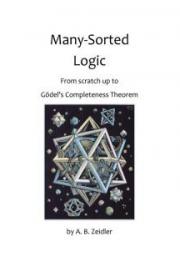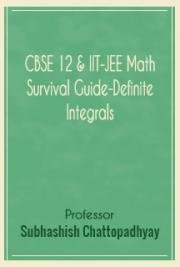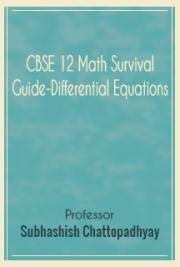
THE EASIEST WAY TO UNDERSTAND ALGEBRA
Roy Richard Sawyer
INTRODUCTION
HOW TO SOLVE EQUATIONS
SYSTEM OF EQUATIONS
QUADRATIC EQUATIONS
APPENDIX 1. ANSWERS TO ALL EQUATIONS
APPENDIX 2. SOLUTIONS FOR ALL EQUATIONS
© Copyright 2017 by Roy Richard Sawyer - All rights reserved
INTRODUCTION
There is a voice inside you that always says," You can't do that. Leave it."
This is not true, but you believe this voice because you get some benefit from accepting the advice. You get a good excuse to slip away from your work. You can go out with friends, watch TV, or do whatever you want. However, you cannot feel genuine pleasure from your entertainment because there is a part of you who wants to be proud of your achievements. This voice tells to "Keep trying! You can do that! You are smart." Believe in what this voice is saying! This tutorial will show you a way of thinking that will help you to understand math. This tutorial is for anyone who wants to feel comfortable using a mathematical formula; who wants to comprehend the beauty of algebraic expressions.
Did you ever feel frustration looking at your math text book? Forget it! Fall in love with math!
1. HOW TO SOLVE THE EQUATIONS
Math is a very enjoyable field of activity. Having just a pen and a piece of paper you can invent whatever you want. You can wander around the paper with numbers and symbols caring about just one thing: equality should be equality, nothing more. Let us imagine that you are the first great mathematician. People are only familiar with arithmetic: how to add, subtract, multiply and divide. In school, they study boring things such as these expressions:
2 + 3 = 5 or 7 - 4 = 3
You are the first who suspects there is a way to express a common idea of the equations written above.
First you write: a + b = c or c - a = b. Now you have discovered common rules that can help people to solve any equation. To verify the discovery, you have to perform experiments with numbers.
Let us write a simple equation: 4 + 8 = 12
Let's add any number to the left side of the equation.
4 + 8 + 3 = 12
What did you get?
15 = 12
This is incorrect! How can you fix your equation? You must add the same number to the right side of the equation.
4 + 8 + 3 = 12 + 3. What did you get? 15 = 15
You discovered the first rule for equations. This rule says: "If you add the same number to the left side and to the right side of an equation, this equation will still be true." To express this rule in a common way you can write:
If a + b = c then a + b + n = C + n where a, b, c, n equal any numbers.
Are you a genius? Of course, you are! Go ahead. Let us try another experiment.
What happens if you subtract any number from the left side of an equation?
5+2=7
5+2-5=7
What did you get? 2 = 7
This is incorrect, but you know how to fix your equation. You must subtract the same number from the left and right side of the equation.
5 + 2 - 5 = 7 - 5. Then 2 = 2.
Congratulations! You discovered the second rule for equations. This rule says: "If you subtract the same numbers from the left and the right side of an equation this equation will still be true."
Or you can write:
if a + b = c then a + b - n = c - n where a, b, c, n equal any numbers.
What other kind of experiments can you do? You can multiply one side of an equation by some number. Let's write an equation:
5 - 1 = 4
What happens, if you multiply the left side of the equation by 7?
(5 - 1)7 = 4 then 28 = 4
This is not true. Try to multiply both sides of the equation by 7.
(5 -1)7= 4 x 7. Then 28 = 28
You discovered one more rule for equations. The third rule says:
" If you multiply the left and the right side of an equation by the same number,
this equation will still be true."
if a - b = c then (a - b)n = (c)n
One more question. What happens if you divide one half of an equation by any number?
4 + 6 = 10
(4 + 6)/2 = 10
then 5 = 10.
You can ask yourself, "How many times will I make the same mistake?"
But you have the knowledge to fix the problem.
You must divide both sides of the equation by the same number.
(4 + 6): 2 = 10: 2 then 5 = 5
You discovered the fourth rule for equations. This rule says:
"If you divide the left and the right side of an equation by the same number the equation will still be true."
So, you can write:
if a + b = c then (a + b)/ n = c/ n
Where a, b, c, are any numbers, but n does not equal to 0 because you can't divide numbers by 0.
People will ask you, "What kind of benefit can you get from these rules?"
Your response will be, "You can use these rules to solve any equation."
Let us write an equation where one number is unknown.
X - 3 = 11
How can we solve this equation? Try to apply the first rule:
If you add the same number to the left and the right side of an equation, this equation will be true.
For our equation, it is convenient to add 3 to both sides of the equation.
X - 3 + 3 = 11 + 3
Since -3 + 3 = 0
Then X = 11 + 3
So, X=14
Let us try to solve an equation where all numbers are represented by lepers.
X - b = c
Apply the first rule to solve this equation
X - b + b = c + b
Since, -b + b = 0, then
X = c + b.
To solve the equation X + b = c we can apply the second rule.
If X + b = c then
X + b - b = c - b
X = c - b.
The next example is X + 7 = 15
then X + 7 - 7 = 15 - 7 and X = 8
Do not proceed until you perform some exercises to become comfortable using the first few rules of equations.
Practice 1. Solving the equations.
Answers
Solutions
Solve for X:
1. X - 5 = 0
2. X + 11 = 3
3. X - ab = 4
4. X - Y = Z
5. X - 2a = c
6. X + 3ab = bc
7. X + k = 1 + k
8. X - ab = a - ab
9. X + c = c - b
10. X - 2a = a - ab
11. X + cb = 3cb - c
12. X - 5 + a = 2a - 5
13. X + 3 - k = 6 - 3k
14. X - 1 - ab = ab - 1
15. X - a - b = a - b
16. X + 2a - 3c = 3a - 2c
You can find the answers in appendix 1. If your answer is wrong try again.
If you can't get the right answer read the solution in appendix 2.
Let's solve the equation
4X - 5 = 15
You can apply the first rule.
4X - 5 + 5 = 15 + 5 then 4X = 20.
How can you find X? You can apply the fourth rule.
If you divide both sides of an equation by the same numbers, this equation will still be true.
4X / 4 = 20 / 4, then X = 5.
To solve equation
aX - b = c
Apply the first rule.
aX - b + b = c + b,
then aX = c + b
Now apply the fourth rule.
If aX = c + b, then aX / a = (c + b) / a
and X = (c + b)/ a
Do not read any more until you perform some exercises.
Practice 2. Solving the equations.
Answers
Solutions
Solve for X:
1. 2X - 3 = 5
2. 3X - 5 = 4
3. 5X + 6 = 36
4. 8X - 5 = 43
5. 7X - 2 = 19
6. 4X + 8 = 20
7. 6X - a = 2a
8. 2X + b = 13b
9. 7X + 3a = a + b
10. 4X - 2a = 4 + 2a
11. 4X - 3a = a
12. 3X - 2b = 6 - 14b
13. 6X - 2a = 24b - 20a
14. aX - 3a = ab - 2a
15. 2aX + ab = 2a - ab
16. 3aX - c = 3ac - 7c
Answers are in appendix 1. Solutions are in appendix 2.
If you have such an equation to solve:
X/a - 5 = 6
Then apply the first rule:
X/a - 5 + 5 = 6 + 5
X/a = 6 + 5
X/a = 11
Then apply the third rule.
X/a * a = 11 *a
X = 11a
Let's solve the equation:
2X - 4b = 2bc
Apply the first rule:
2X - 4b + 4b = 2bc + 4b,
then 2X = 2bc + 4b
Apply the third rule:
2X/ 2 = (2bc + 4b) / 2
You should know how to divide a binomial by a monomial.
If you have forgotten it, you could find the rule by yourself. Can you write?
(2bc+ 4b)/2 = 2bc/2 + 4b/2. Yes, you can.
Let' us check. Suppose, c = 2 and b = 3.
To divide a binomial by 2, try to divide each monomial by 2
2*3*2/2 + 4*3/2 = 12
Now try to solve the binomial first and then divide by 2
(2*3*2 + 4*3)/2 then 24/2 = 12
We got the same answer. It means that
(a+ b)/2 = a/2 + b/2.
We discovered a rule: To divide a binomial by a number, divide each monomial
inside the binomial by that number. Come back to your equation.
2X = 2bc + 4b. Then
2X / 2 = 2bc / 2 + 4b / 2
Then X = bc + 2b
You can factor out b and get
X = b(c + 2)
Whenever you don't know the rule, you can put any numbers in place
of the letters and check equality. Discover rules by yourself.
Let us solve a more complicated equation:

Multiply both sides of the equation by 5X.

5X - 5 = 50X Use the 2nd rule, subtract 5X from both sides:
5X - 5 - 5X = 50X - 5X
or 45X = - 5
Divide both sides by 45

X = - 1/9
The next equation:

Find the common denominator:



Since, +aX -aX = 0 our equation becomes simple:

Use the 3rd rule: multiply both sides of the equation by (a + b)

Then b - bX = c(a + b)
Apply the 2nd rule, subtract b from both sides of the equation:
b - bX - b =c (a + b) - b
Then -bX =c (a + b)-b Divide both sides by b:


To make this algebraic expression more beautiful, multiply the numerator and denominator by (-1).
You can do that because (-1):(-1)= 1. If you multiply any number by 1 the number will not be changed.

then

The next equation:
-2X = a - b
It is not convenient for you to have a minus in front of 2X.
You can change the equation into a more convenient form.
Let's multiply both sides of the equation by -1
(-2X)(-1) = (a - b)(-1) then you get
2X = -a + b or 2X = b - a Divide both sides by 2:

There is another way to solve this equation:
- 2X = a - b
Let's divide both sides of the equation by -2

To make your result more beautiful you can multiply the numerator and the denominator by - 1

The next equation:
3a - 6X = 6X - 9a
You can see that on the left side of the equation you have -6X
and on the right side +6X. It is more convenient for you to have a + in front of X,
therefore, you leave +6X on the right side and get rid of -6X in the left side of the equation.
Add 6X to both side of the equation:
3a - 6X + 6X = 6X - 9a + 6X then 3a = 12X - 9a
Add 9a to both side of the equation:
3a + 9a = 12X - 9a + 9a then 12a = 12X X = a
Do not read any more until you perform some exercises.
Practice 3. Solving the equations
Answers
Solutions
(Solve for X)
1. 1 - X = 5 - a
2. 1 - 2X = X - 4
3. a - 3X = b - X
4. 2a - 4X = 2X - 4a
5. 4b - 2X = 2X - 4b
6. ab + aX = 2aX + ac
7. ab + aX = 2aX - ac
Let us continue and discus the equation:
aX - bX = a - b
Factor out X which is a common factor for binomial aX - bX,
then you get X (a - b) = a - b
Divide each part of the equation by a - b
X(a - b)/(a - b)=(a - b)/(a - b)

X = 1
Do not read any more until you perform exercises.
Practice 4. Solving the equations.
Answers
Solutions
(Solve for X)
1. bX - 2b = aX - 2a
2. b - 2bX = a - 2aX
3. aX - bX = 1
4. aX - bX - cX = 2a - 2b - 2c
5. 3abX - 5a = 3acX + 13a
6. aX - bX = ac - bc
7. 9a - 4X = 5a - 2X
8. X - aX = 2 - 2a
9. aX - bX = b - a
Let us continue and solve the equation:
aX - bX = 2b - 2a Factor out X from the left side of the equation.
X(a - b) = 2b - 2a Factor out 2 from the right side of the equation.
X(a - b) = 2(b - a) then divide both sides by (a - b)

Factor out (-1) from the numerator

Or you can simplify this algebraic expression by factoring out (-1) from the denominator

Practice 5. Solving the equations.
Answers
Solutions
Solve for X.
1. 5aX - 5bX = 10b - 10a
2. aX - bX - cX = c + b - a
3. 2X - 3aX = 6a - 4
4. 3aX - 9bX = 27b - 9a
5. 4bX - cX = 8c - 32b
6. abX - acX = ac - ab
7. X/2 - aX = 1 - 2a
8. aX/5 + 2a = 5a - 4aX
You can find the answers in appendix 1 and the solution in appendix 2.
2. SYSTEM OF EQUATIONS
Look at the equation X + Y = 3. X and Y are unknown. You can´t find neither X nor Y from this equation. You need additional information about the "relationship" between them. Such information may be included in an additional equation. For example: X - Y = - 1. Now you have a system of 2 equations:
1. X + Y = 3
X - Y = -1
There are several ways to solve it. The first way: solve for X in any equation, for example, the first one.
For that subtract Y from each side of the equation:
X + Y - Y = 3 - Y; Find X
X = 3 - Y
Then put (3 - Y) in place of X in the second equation (X - Y = -1).
You will obtain: 3 - Y - Y = -1 or 3 - 2Y = -1
Now solve that equation for Y. Add 2Y to both sides of the equation.
3 - 2Y + 2Y = -1 + 2Y
3 = -1 + 2Y
Add 1 to both sides of the equation.
3 + 1 = -1 + 1 + 2Y
4 = 2Y
Switch 4 and 2Y
2Y = 4
Divide both sides of the equation by 2.
2Y/2 = 4/2
Y = 2. Now put 2 in place of Y in any original equation to find X.
One of the original equations is X + Y = 3
X + 2 = 3;
Subtract 2 from both sides of equation.
X + 2 - 2 = 3 - 2;
X = 1
Y = 2
The second way:
1. X + Y = 3
X - Y = -1
You can sum the left sides of both equations and sum the right sides of both equations.
If X + Y = 3 and X - Y = -1 Then
(X + Y) + (X - Y) = 3 + (-1) or
You can write it in this way:

Then X = 1
Put 1 in place of X in any equation.
1 + Y = 3
Subtract 1 from both sides of the equation.
1 + Y - 1 = 3 - 1
Y = 3 - 1
Y = 2
We can solve system equations using their graphs. If we plot each equation, we will get two straight lines. The point of the intersection of the lines will have values X and Y that fit both equations.
To draw a graph for an equation, we have to change it to a general form: Y = aX + b
Let's start from the first equation: X + Y =3
Subtract X from both sides of the equation
X - X + Y = 3 - X
Y = 3 - X
Find 2 points to draw the first equation. Assign any value to X and calculate the value of Y.
X = 3; Y(3) = 3 - 3 =0
X = 6; Y(6) = 3 - 6 = - 3
Two points are enough to draw a straight line.
Let's find points for the second equation. Change form to general one.
X - Y = -1
Subtract X from both sides of the equation
X - X - Y = - 1 - X
- Y = - 1 - X
Multiply both sides by -1
-Y(-1) = (-1)(-1) - X(-1)
Y = 1 + X
Find 2 points to draw the second equation. Assign any value to X and calculate the value of Y.
X = 5; Y(5) = 1 + 5 = 6
X = -5; Y(-5)= 1 - 5 = -4
Now we can draw graphs for both lines.
In graph 1, you see that the lines intersection point has X = 1 and Y =2. They are the same values we found before.

Graph 1. A point of the intersection: X=1, Y=2.
The next system of equations is:
2. 2X + Y = 5
X + Y =2
In this case, we have + in front of X and Y in both equations.
To eliminate one unknown member of the equation you have to subtract the second equation from the first one.
(2X + Y) - (X + Y) = 5 - 2

Then put 3 in place of X in any original equation.
3 + Y = 2
Subtract 3 from both sides of the equation.
3 + Y - 3 = 2 - 3
Y = 2 - 3 = - 1
Y = -1
Answers: X = 3; Y = -1;
Let 's solve these equations using graph.
The first equation is 2X + Y = 5.
Change it to a general form Y = aX + b
Subtract 2X from both sides of the equation.
2X - 2X + Y = 5 - 2X
Y = 5 - 2X
Find 2 points to draw the first equation. Assign any value to X and calculate the value of Y.
X = 0; Y(0)= 5 -2* 0; Y(0) = 5
X = 4; Y(4) = 5 - 2*4 = 5 - 8 = - 3
Let's find 2 points for the second equation.
X + Y = 2
Change it to a general form Y = aX + b
X - X + Y = 2 - X;
Y = 2 - X
Find 2 points to draw the second equation. Assign any value to X and calculate the value of Y.
X = 4; Y(4) = 2 - 4 = - 2
X = - 4; Y(-4) = 2 - (-4) = 2 + 4 = 6
In graph 2, we can see that the point of the intersection is (3, -1). The same answer we found before: X = 3, Y= -1

Graph 2.The point of the intersection: X=3, Y=-1.
The next system of equation is:
3. X - Y = 3
3X - 2Y = 4
To eliminate one unknown member of the equation you have to get the same number in front of X in the first and in the second equation or the same number in front of Y in the first and in the second equation. In our case, in front of Y you have -1 in the first equation and -2 in the second equation.
To get -2Y in the first equation you should multiply both sides of the equation by two. Then you will get:
2X - 2Y = 6
3X - 2Y = 4
Now subtract the second equation from the first one.

then X = - 2
Put -2 in place of X in any original equation.
- 2 - Y = 3
Add 2 to both sides of the equation
- 2 - Y + 2= 3 + 2
- Y = 5
Multiply both sides of the equation by - 1
- Y * (-1) = 5 * (-1)
Y = - 5
You can check your result. Put -2 in p

































